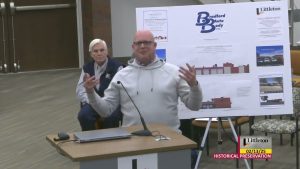When it comes to building a gas station, the foundation is one of the most significant aspects of the entire project. The right foundation ensures durability, stability, and safety for the entire structure. That’s why it’s essential to get it right. In this section, we’ll give you an introduction to concrete foundation work gas station and the vital factors you need to consider before embarking on such a project. We’ll also explore the different types of concrete foundation services that are commonly used in gas station construction.
Without a solid foundation, a gas station could develop structural problems that could significantly impact its usability and safety over time. By understanding the importance of having the right foundation, you can take the necessary precautions to ensure that your gas station is built to last.
Choosing the Right Concrete Foundation Contractors for Your Gas Station
Choosing the right concrete foundation contractor is a critical step in ensuring the success of your gas station construction project. Here are some qualities that you should look for in a contractor:
- Experience: Choose contractors with a proven track record in gas station foundation work. Check their portfolio to see their previous projects and verify their credentials.
- Attention to detail: A good contractor should pay attention to every detail in the project, from the excavation to the finishing. They should also be willing to listen to your needs and preferences and provide suggestions for the best outcome.
- Effective communication: Clear communication between the contractor and the client is crucial for the success of the project. Choose a contractor who is readily available and responsive to your inquiries and concerns.
- Licensing and insurance: Ensure that the contractor is licensed to operate in your state and carries adequate insurance coverage. These certifications demonstrate the contractor’s professionalism and commitment to quality work.
Once you have a list of potential contractors, narrow it down by vetting them using the following criteria:
- References: Ask for references from previous clients and follow up with them to gauge their satisfaction with the contractor’s work.
- Portfolio review: Check the contractor’s portfolio to see the quality of work they produce. Look for projects that are similar in scope and size to yours.
- Licensing and insurance verification: Verify that the contractor is licensed, bonded, and insured. You can do this by checking with your state’s licensing board.
- Cost estimate: Ask for a detailed cost estimate for the project, broken down by material and labor costs. Compare this estimate with those of other contractors and ensure there are no hidden or surprise costs.
By following these tips, you can choose a reliable and professional concrete foundation contractor who will help you build a sturdy and long-lasting foundation for your gas station.
Designing a Robust Gas Station Foundation
Designing a gas station foundation requires careful consideration of various factors to ensure its durability and stability. Concrete foundation contractors take into account the site conditions, soil type, and environmental regulations to create a robust foundation for gas stations.
Site Conditions
The site conditions play a critical role in the design of a gas station foundation. The contractor must evaluate the soil bearing capacity, slope, and drainage to determine the best method to support the weight of the fuel tanks and pumps.
If the soil is not stable enough, additional preparation may be necessary, such as ground improvement techniques like compaction or soil stabilization. Slope can also affect the foundation design by requiring either a stepped or tapered foundation. Drainage is essential in preventing water infiltration that could compromise the foundation’s stability.
Soil Type
The type of soil also plays a significant role in the design of the foundation. Some soils, such as clay, can expand or shrink under different moisture conditions, while others, such as sand, can compact under heavy loads. The contractor must ensure that the foundation design accommodates the specific soil characteristics on site.
| Soil Type | Characteristics |
|---|---|
| Clay | Expands and shrinks under different moisture conditions |
| Sand | Compacts under heavy loads |
| Rock | Requires specialized equipment for excavation |
Environmental Regulations
Environmental regulations can also impact the design of a gas station foundation. For example, in areas with high seismic activity, the foundation may require special reinforcement to withstand earthquakes. In areas with a high water table, the foundation may require a waterproofing layer to prevent water infiltration.
Moreover, in areas with strict environmental regulations, the contractor must ensure that the foundation design complies with the relevant codes and guidelines. Failure to comply with such regulations may result in fines and legal penalties.
Concrete Slab for Gas Station: Construction Process & Best Practices
Constructing a concrete slab for a gas station is a complex process that requires careful planning and execution to ensure a durable and efficient foundation. Below, we outline the various steps involved in the construction process and highlight some best practices that contractors should follow to create a robust concrete slab.
Excavation
The first step in constructing a concrete slab for a gas station is excavation. This involves removing the topsoil and other debris from the site to create a level base for the foundation. Once the excavation is complete, contractors may need to introduce gravel or other types of aggregate to help provide additional support and drainage.
Framing
After excavation, framing is the next step in constructing a concrete slab. Contractors must build a wooden frame around the perimeter of the excavation site to provide a boundary for the poured concrete. It’s essential to ensure that the frame is level and secure, as it will determine the overall shape and size of the concrete slab.
Pouring
Once the framing is complete, it’s time to pour the concrete. Contractors must mix the concrete according to the proper specifications and pour it into the frame. It’s crucial to ensure that the concrete is distributed evenly and that there are no air pockets or other imperfections. Once the concrete is poured, contractors must smooth its surface using special tools to create a level finish.
Finishing
After the concrete is poured and smoothed, it’s time to finish the surface. This involves adding a layer of sealant or other protective materials to protect the concrete from water damage, cracking, and other types of wear and tear. Contractors may also choose to add decorative elements such as colored coatings, stamps, or textures to improve the aesthetics of the slab.
Overall, constructing a concrete slab for a gas station requires expertise and experience. By following the best practices outlined above, contractors can create a foundation that meets the unique needs of a gas station while ensuring longevity and durability.
Foundation Repair for Gas Stations: Common Causes & Solutions
Gas station foundations can sustain damage due to a variety of factors. The most common causes of foundation damage in gas stations include:
- Soil settlement: This occurs when the soil underneath the foundation shifts or compacts, leading to cracks and unevenness in the foundation.
- Water infiltration: Water can seep into the foundation and cause it to weaken or crack.
- Natural disasters: Earthquakes, floods, and other natural disasters can cause significant foundation damage.
If you notice any signs of foundation damage, such as cracks in the walls or floor, it’s important to contact a professional concrete foundation contractor right away. They can assess the damage and recommend the best course of action.
Some common repair solutions for gas station foundations include:
- Crack injection: This involves injecting a resin or epoxy into the cracks to fill them and prevent further damage.
- Slab jacking: This technique involves raising the foundation slab by pumping grout or a similar material under it.
- Piering: This involves installing steel or concrete piers under the foundation to provide additional support and stabilize the foundation.
The right repair solution for your gas station foundation will depend on the type and extent of the damage, as well as other factors such as the soil type and environmental regulations. It’s important to work with a reputable and experienced concrete foundation contractor to ensure that the repairs are done correctly and effectively.
Gas Station Pump Installation: Key Considerations & Safety Measures
Installing gas station pumps requires careful planning and execution to ensure safe and efficient operation. Here are some key considerations and safety measures to keep in mind:
Pump Location
The location of the pump is critical for efficient fueling and customer convenience. It is essential to ensure that the pump is placed in a well-lit and easily accessible area. Additionally, the pump should be positioned at least 10 feet away from the building and any other flammable materials.
Ventilation
Adequate ventilation is necessary to prevent the buildup of hazardous vapors. Gas station pumps should be designed with proper ventilation systems that comply with relevant codes and regulations. Proper ventilation also helps to prevent the buildup of heat, which can be dangerous.
Electrical Connections
Gas station pumps require a reliable electrical power source to operate effectively. A licensed electrical contractor should handle all electrical connections, ensuring compliance with relevant codes and safety requirements. Any electrical work should be inspected and approved by local authorities before use.
Fire Prevention Measures
The risk of fire is always present at gas stations. It is crucial to have fire prevention and safety measures in place, such as fire extinguishers, automatic shut-off valves, and smoke detectors. All employees should be trained in fire safety procedures and emergency response.
By following these key considerations and safety measures, gas station owners can ensure safe and efficient pump installation, reduce the risk of accidents, and promote a positive customer experience.
Gas Station Construction Cost: Factors that Affect the Total Cost
Gas station construction can be a costly investment. The total cost of constructing a gas station is influenced by several factors. Here are some of the factors that affect gas station construction cost:
| Factors | Description |
|---|---|
| Site location | The location of the gas station can significantly impact the construction cost. The cost of land varies depending on the location, and some locations may require more preparation work before construction, increasing the cost. |
| Soil Type | The soil condition of the site can affect the foundation design and construction cost. A site with poor soil conditions will require additional preparation work, such as soil stabilization, before the foundation can be installed. |
| Foundation design | The foundation design depends on several factors such as the soil condition, site location, and the weight of the gas station. A complex foundation design will require more materials and labor, thus increasing the construction cost. |
| Type of fueling system | The type of fueling system that is installed affects the construction cost. Installing a more advanced fueling system, such as a compressed natural gas station, will increase the cost compared to installing a simple gasoline station. |
| Construction materials | The type and quality of construction materials used can affect the construction cost. Using high-quality materials such as steel and reinforced concrete will increase the cost compared to using lower quality materials. |
It is crucial to keep these factors in mind when planning a gas station construction project. By carefully considering these factors, gas station owners can keep their construction costs under control and ensure a successful construction project.
Maintenance Tips for a Durable Gas Station Foundation
Maintaining a durable gas station foundation is crucial to ensure the safety of your customers and employees while also protecting your investment. Here are some practical tips to help you keep your concrete foundation in top shape:
- Regular Inspection: Schedule regular inspections of your gas station foundation to detect any signs of damage or wear and tear. A professional concrete foundation service provider can help you identify potential issues and recommend appropriate solutions.
- Damage Prevention: Take proactive measures to prevent damage to your foundation, such as ensuring proper drainage, avoiding heavy vehicle traffic in certain areas, and installing protective barriers or bollards where needed.
- Timely Repairs: Address any foundation damage promptly to prevent it from worsening and causing more significant issues. Work with a qualified concrete foundation contractor to repair any cracks, gaps, or other signs of damage
- Invest in Professional Concrete Foundation Services: Regularly investing in professional concrete foundation services can help prevent minor issues from becoming major problems. Professional services, such as concrete resurfacing, lifting, and leveling, can keep your foundation in good condition for longer periods.
By following these maintenance tips, you can prolong the life of your gas station foundation, save on repair costs, and ensure the safety of your customers and employees.
FAQ
Here are some answers to frequently asked questions about concrete foundation work for gas stations:
What are the benefits of concrete foundations over other materials?
Concrete foundations offer excellent durability and resistance to environmental factors such as moisture, temperature changes, and chemical exposure. They are also relatively easy to install and maintain, making them a popular choice for gas station owners.
How long does it take to complete a gas station foundation?
The timeline for completing a gas station foundation depends on several factors, such as the size and complexity of the project and the weather conditions. A typical foundation construction project can take anywhere from a few weeks to several months to complete.
What are the most common mistakes that contractors make during foundation construction?
Some of the most common mistakes that contractors make during foundation construction include improper soil preparation, incorrect mixing and pouring of the concrete, inadequate reinforcement, and poor drainage design. To avoid these mistakes, it is essential to choose experienced and licensed contractors who use industry best practices.
What is the best way to maintain a gas station foundation?
To ensure the longevity and durability of a gas station foundation, regular inspection and maintenance are crucial. Gas station owners should schedule periodic inspections to check for cracks, settling, or other signs of damage. They should also avoid overloading the foundation with heavy equipment and vehicles and ensure that drainage systems are functioning correctly. Prompt repairs and professional concrete foundation services can also help prevent costly damage and extend the life of the foundation.
Should I hire a professional concrete foundation contractor or attempt the work myself?
While it may be tempting to attempt foundation construction or repair work yourself, this can be a risky and costly endeavor. Concrete foundation work requires specialized skills, equipment, and knowledge of local building codes and regulations. Hiring a licensed and experienced contractor is the best way to ensure that the work is done correctly and safely.









